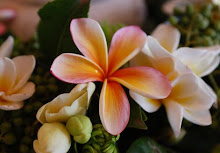
Australian frangipani growing history varied and colorful, just like the plants themselves. In the late 19th and early 20th centuries in Australia's top end, Christian missionaries coming mainly from Samoa and Vanuatu, established mission settlements for the local Aborigines. They brought with them their favourite sacred frangipanis for planting around the missions.
Although the missions were finally abandoned, old mango trees, coconut palms and frangipanis have survived, despite cyclones, prolonged droughts and frequent bush fires. This cultivator, "Queen Napranum" was discovered growing wild at an abandoned Samoan-run mission in Top End country. Cuttings from these trees were taken in early 1920's and these days one can see many "Queen Napranum" trees in Australian gardens. This variety have great drought resistance and incredible vigor.
Imagine my delight when I spotted this tree on my early morning walk! Knowing it's history, I just had to take a picture and to admire it's special and beautiful colorful blooms.
The sun was just about to come out and this frangipani's aroma was strong peach scent - heady and intoxicated! They say that "fragrance lies in the nose of the inhaler", of course, I agree and with so many varieties of frangipanis - what a sweet opportunity for investigation!































